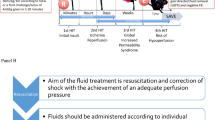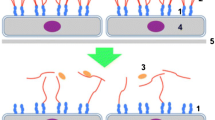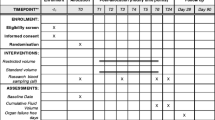Abstract
The inflammatory storm, as well as the direct effect of endotoxins on endothelium, may induce hemodynamic instability. Targeted fluid replacement plays a key role in endotoxic shock, with the aim of balancing resuscitation thus avoiding additional harm. Many types of solutions are available for fluid administration. Currently, some study groups promote the use of intravenous balanced solutions whilst chloride administration may impact on renal function even at low doses by causing both tubular dysfunction and arteriolar vasoconstriction. Synthetic colloids usage is contraindicated. There is still a controversial role of albumin; SSC2021 guidelines suggest administering albumin to avoid the infusion of an exaggerated volume of crystalloids to restore hemodynamic stability (weak recommendation, low quality of evidence). The hemodynamic effects and the reliability of these dynamic indices of fluid responsiveness are well described in literature. Further research on this topic is warranted, to avoid crossing the threshold between active management and noxious actions, a daily challenge in critical care medicine.
Access this chapter
Tax calculation will be finalised at checkout
Purchases are for personal use only
Similar content being viewed by others
References
Aya HD, Ster IC, Fletcher N, Grounds RM, Rhodes A, Cecconi M. Pharmacodynamic analysis of a fluid challenge. Crit Care Med. 2016;44(5):880–91.
Lambden S, Creagh-Brown BC, Hunt J, Summers C, Forni LG. Definitions and pathophysiology of vasoplegic shock. Crit Care. 2018;22(1):174.
Lange M, Enkhbaatar P, Nakano Y, Traber DL. Role of nitric oxide in shock: the large animal perspective. Front Biosci. 2009;14(5):1979–89.
Draisma A, Dorresteijn MJ, Bouw MP, van der Hoeven JG, Pickkers P. The role of cytokines and inducible nitric oxide synthase in endotoxemia-induced endothelial dysfunction. J Cardiovasc Pharmacol. 2010;55(6):595–600.
Kirkebøen KA, Strand OA. The role of nitric oxide in sepsis—an overview. Acta Anaesthesiol Scand. 1999;43(3):275–88.
Villela NR, dos Santos AOMT, de Miranda ML, Bouskela E. Fluid resuscitation therapy in endotoxemic hamsters improves survival and attenuates capillary perfusion deficits and inflammatory responses by a mechanism related to nitric oxide. J Transl Med. 2014;12(1):232.
Bakker J, Grover R, McLuckie A, Holzapfel L, Andersson J, Lodato R, et al. Administration of the nitric oxide synthase inhibitor NG-methyl- L-arginine hydrochloride (546C88) by intravenous infusion for up to 72 hours can promote the resolution of shock in patients with severe sepsis: results of a randomized, double-blind, placebo-controlled multicenter study (study no. 144-002). Crit Care Med. 2004;32(1):1–12.
Malbrain MLNG, Langer T, Annane D, Gattinoni L, Elbers P, Hahn RG, et al. Intravenous fluid therapy in the perioperative and critical care setting: executive summary of the International Fluid Academy (IFA). Ann Intensive Care. 2020;10(1):64.
Shinotsuka CR, Caironi P, Villois P, Fontana V, Vincent J, Creteur J, et al. Assessment of chloride levels on renal function after cardiac arrest. Intensive Care Med Exp. 2015;3(1):1–2.
Evans L, Rhodes A, Alhazzani W, Antonelli M, Coopersmith CM, French C, et al. Surviving sepsis campaign: international guidelines for management of sepsis and septic shock 2021. Intensive Care Med. 2021;47:62.
Cecconi M, Hofer C, Teboul JL, Pettila V, Wilkman E, Molnar Z, et al. Fluid challenges in intensive care: the FENICE study: a global inception cohort study. Intensive Care Med. 2015;41(9):1529–37.
Estrada CA, Murugan R. Hydroxyethyl starch in severe sepsis: end of starch era? Crit Care. 2013;17(2):310.
Belcher DA, Williams AT, Palmer AF, Cabrales P. Polymerized albumin restores impaired hemodynamics in endotoxemia and polymicrobial sepsis. Sci Rep. 2021;11(1):10834.
Cecconi M, Parsons AK, Rhodes A. What is a fluid challenge? Curr Opin Crit Care. 2011;17(3):290–5.
Cecconi M, Monge García M, Gracia Romero M, Mellinghoff J, Caliandro F, Grounds R, et al. Use of pulse pressure variation and stroke volume variation in spontaneously breathing patients to assess dynamic arterial elastance and to predict arterial pressure response to fluid administration. Critical Care. 2014;18(1):1–182.
Esposito ML, Bader Y, Morine KJ, Kiernan MS, Pham DT, Burkhoff D, Navin K, Kapur MD. Mechanical circulatory support devices for acute right ventricular failure. Circulation. 2017;136:314–26.
Miller A, Mandeville J. Predicting and measuring fluid responsiveness with echocardiography. Echo Res Pract. 2016;3(2):G1.
Lujan Varas J, Martinez Díaz C, Blancas R, Martinez Gonzalez O, Ruiz L, Montero M, et al. Inferior vena cava distensibility index predicting fluid responsiveness in ventilated patients. Intensive Care Med Exp. 2015;3(Suppl 1):A600.
Vignon P, Vignon P. Evaluation of fluid responsiveness in ventilated septic patients: back to venous return. Intensive Care Med. 2004;30:1699–701.
Feissel M, Michard F, Mangin I, Ruyer O, Faller JP, Teboul JL. Respiratory changes in aortic blood velocity as an indicator of fluid responsiveness in ventilated patients with septic shock. Chest. 2001;119(3):867–73.
Jozwiak M, Teboul JL, Monnet X. Extravascular lung water in critical care: recent advances and clinical applications. Ann Intensive Care. 2015;5:38.
Byrne L, Obonyo NG, Diab SD, Dunster KR, Passmore MR, Boon AC, et al. Unintended consequences: fluid resuscitation worsens shock in an ovine model of endotoxemia. Am J Respir Crit Care Med. 2018;198(8):1043–54.
Author information
Authors and Affiliations
Corresponding author
Editor information
Editors and Affiliations
7.1 Electronic Supplementary Material
Data 7.1
(PPTX 201 kb)
Rights and permissions
Copyright information
© 2023 The Author(s), under exclusive license to Springer Nature Switzerland AG
About this chapter
Cite this chapter
Savi, M., Montisci, A., Greco, M. (2023). Clinical Management of Endotoxemia: Volume Support. In: De Rosa, S., Villa, G. (eds) Endotoxin Induced-Shock: a Multidisciplinary Approach in Critical Care. Springer, Cham. https://doi.org/10.1007/978-3-031-18591-5_7
Download citation
DOI: https://doi.org/10.1007/978-3-031-18591-5_7
Published:
Publisher Name: Springer, Cham
Print ISBN: 978-3-031-18590-8
Online ISBN: 978-3-031-18591-5
eBook Packages: MedicineMedicine (R0)




